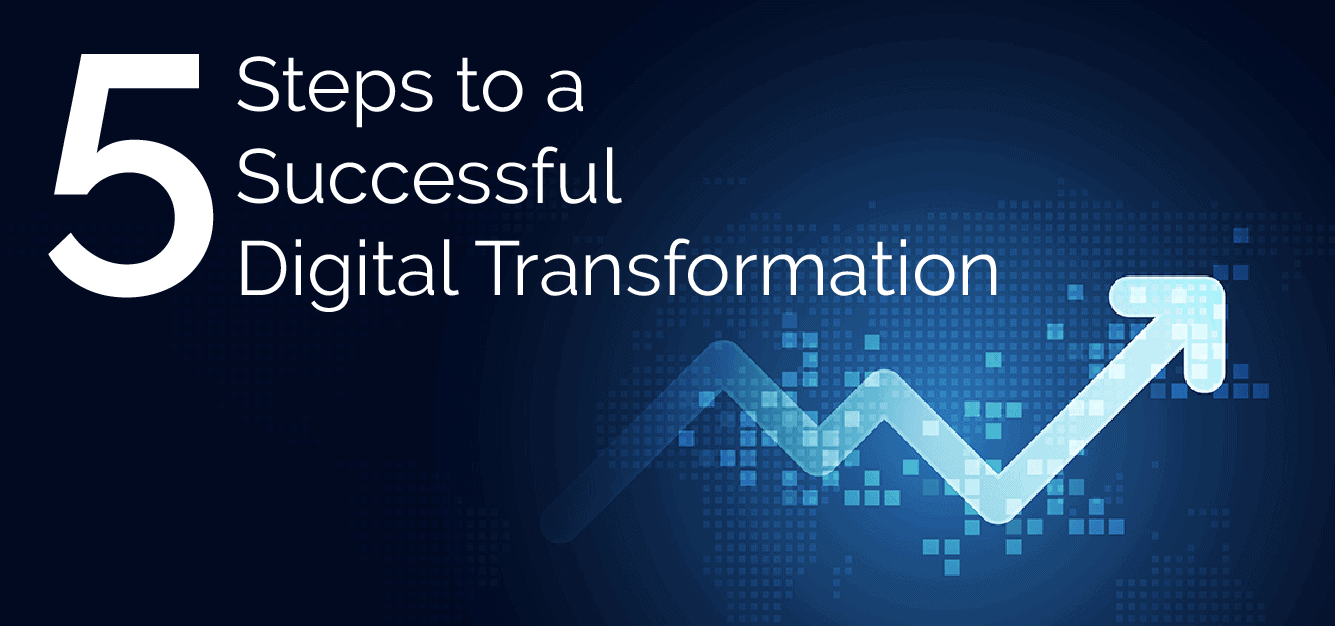Five-Steps to a Successful Digital Transformation
A successful digital transmission adoption depends on having a sound strategy. Businesses that have successfully embraced digital transformation don’t just adopt individual technologies to solve their problems. More often than not, they have a defined strategy with clear objectives to guide the transformation of their overall business.
What follows are five steps, that when mapped out and implemented properly, will help you develop a successful digital transformation strategy for your business that will reap benefits almost immediately.
1. What is Your Digital Transformation Objective?
When adopting new technologies, there are two missteps that businesses often make. First, they look to embrace technologies currently in use in other departments within their company, or even look to an application currently in use by a competitor. Second, they look to improve their capabilities without giving any thought to specific goals or problem areas that they want to be solved. So, in effect, they may still be spinning their wheels because it’s not solving their current isolated and siloed company-wide technology issues, making it even more difficult to integrate and scale in the future.
The better way is to start by defining what you want your business to accomplish through digital transformation. Define what a successful digital transformation means for your overall business and for your customers. And make sure that includes what would make for better customer engagements and experiences. By establishing these objectives, your business can adopt the right technologies, keeping a clear focus on improving the overall business, instead of just individual processes. Not only does this help in developing a comprehensive strategy that involves and transforms the entire business, but it also avoids the siloed adoption of technologies, including disconnected legacy systems and unorganized databases.
Defining the overall objective is the most important step in developing your digital transformation strategy. It aligns and drives transformation at every level of the business, even reaching the customers, enabling you to create a lasting competitive advantage. In addition, it provides a reference point for assessing and determining specific actions to take and initiatives to act upon in the transformation process.
2. Design Your Customer and Employee Experience
With defining your objectives behind you, it’s now time to focus on designing the experience you envision for your customers and employees. Remember, a proper digital transformation prioritizes and values user experiences as much as it adds and introduces new functions and capabilities. So, instead of only focusing on the requirements of new solutions and the constraints of your current technologies, your business also needs to focus on the experiences you want to provide your end-users.
For this step, your overall transformation objectives should be mapped out as specific and detailed goals. These goals should include how a staff member’s work can be streamlined via new software, applications, or functionalities. For customers, goals should be focused on things such as making a better shopping experience through your website or mobile app. And don’t forget to include ways your staff members can better collaborate, engage, and interact not only with each other but with your customers through your new digital platforms and technologies.
3. Evaluate Your Current Technologies
In the first two steps, we talked about where your business wants to be and what you want to achieve through digital transformation. The next step will be a hard look at where you currently are and gives you an idea of where your business started in its journey and the gaps that need to be filled.
In this third step, take stock of your company’s existing software, applications, and technologies. You have to determine, based on the objectives you established and the design you’ve created, which specific technologies need to stay active, upgraded, automated, or discontinued.
The goal in this step is to match the technologies with the outcomes they deliver and the problems they solve. This can help prioritize the technologies that will be updated in your digital transformation and align them with the objectives and the desired experience. It can also help determine the integration solutions your business needs to bring together siloed and disparate systems.
4. Your Solutions and Partners
Step four in your digital transformation strategy is centered on assessing and selecting possible solutions to meet your established objectives, your desired staff and customer experiences, and filling in the gaps of your existing technologies.
If you don’t have the internal capabilities to make your digital transformation upgrades and need to outsource your solution, this step’s main requirement is that you complete a careful and thorough review of possible solutions and offerings from different vendors. In addition to the capabilities and functionalities of the solutions a vendor can offer, they should also have a proven track record and should be flexible to work with. The vendor also needs to be able to provide the necessary post-sales support without delay. It’s not out of the question that problems could arise after the development and implementation of your chosen solution.
You may also want to consider creating a comparison chart of solutions and vendors. Think of it as an objective tool in your quest for making an informed choice.
5. The Digital Transformation Implementation Timeline
The fifth and final step in your digital transformation plan assembles the overall business objectives, desired experiences, existing technologies, and possible solutions together and consolidates them into an actionable plan. A digital transformation initiative takes time and resources, both human and financial, thus the reason it is often done in stages. It is critical to carefully plan when each action — such as a technology assessment or a vendor meeting — should be taken to ensure that human and capital resources are available.
Your implementation timeline will also give all stakeholders, from C-suite executives to staff members and customers, a much-needed heads-up to generate support for the digital transformation initiative while minimizing disruptions to your business operations. A digital transformation project, like any other business project, requires continuous support from every corner of the organization to ensure its success.
Finally, an implementation timeline provides your business with a benchmark it can use to compare actual results with planned results. It also aids the project leaders in managing and governing the project.
By following these simple, but important steps outlined above, your business will be well on its way to developing a successful and seamless digital transformation strategy.
At Ad Victoriam Solutions, our consulting team helps companies with their digital transformation strategies every single day, and every step of the way. Our certified experts learn your business, connect your data, then help your company deliver the type of customer experience that taps into the preferences of your modern customer. Let’s put a plan together today!
Related Article:
It’s the Best Time for Digital Transformation – Here’s Why


